In principle, losing weight and shedding fat will occur when you expend more calories than you consume.
This is a scientific fact, however the reality of applying this in day-to-day life is, of course, much more complex.
So how do you reach your specific goal?
Everyone is different and whether you want to lose fat, improve performance, build muscle or just improve functional performance, these principles are important for you to understand and apply.
Structuring a Diet
TIP: The first 2 points are the most important and will account for 75 – 80% of your success.
Make sure that you dial these in before thinking about the other aspects of your nutrition. These are calorie balance and macronutrients.
Notice on the chart below how these factors measure up against the others to construct your overall nutrition in terms of importance.
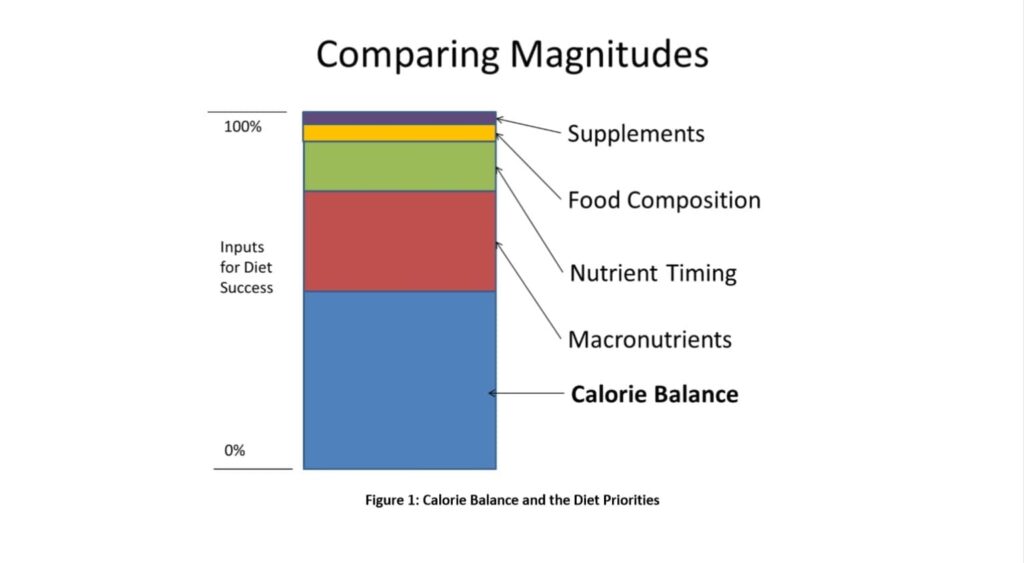 Source: Renaissance Periodization
Source: Renaissance Periodization1. Calorie Balance
Calorie balance is the ratio between calories taken in and calories expended in any one individual at any given time. It is a good idea to measure this out over the course of a week to cancel out most fluctuations, such as drinking more water.
TIP: When measuring fat loss (or muscle gain) over time, weigh yourself first thing in the morning, before you eat or drink anything. Measure your weight 2-3 times per week and record all results. This will give you a clear and consistent record of your progress.
There are 3 states of calorie balance:
- Negative calorie balance (hypocaloric diet)
- Calorie balance (eucaloric diet)
- Positive Calorie balance (hypercaloric diet)
It is impossible to be in more than one of these states at any one time.
- A negative calorie balance will always result in weight loss. “Even though body water alterations may occasionally mask this loss of tissue, it is always going to occur, with ZERO exceptions so far discovered.”
- A eucalorie balance means that the athlete will not gain or lose weight because they expend as many calories as they consume.
- A positive calorie balance means that the individual is consuming more calories than they are using.
In order to maximize your chances for muscle gain or fat loss, you must know when and how to enter a hypo, hyper, or eucaloric state.
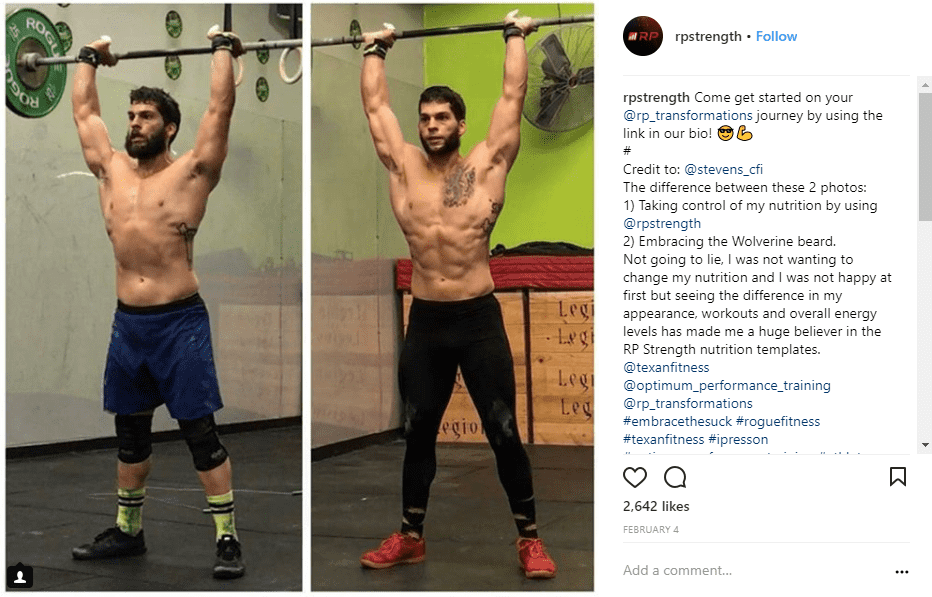 Source: Renaissance Periodization
Source: Renaissance PeriodizationThis can be dauting at first, but help is always on hand when you want to learn more. If a diet is truly hypocaloric, it will ALWAYS result in weight loss over the medium and long term. This links back to the primary principle of weight loss that we outlined above.
To put it simply, if your weight is steadily rising, you’re hypercaloric. If your weight is stable, you’re eucaloric, and if your weight is steadily falling, you’re in a hypocaloric state.
2. Shed Fat: Correct Macronutrients
The second most important factor for transforming yourself is to consume the correct macronutrients to support your body and the goals that you are working towards. These consist of proteins, carbohydrates and fats. Having the right ratio between these three parts of your nutrition will differ depending on your exact goal, weight, sex, age, height and the way that you train.
Renaissance Periodization take all this into consideration and give you a flexible template that will teach you exactly what ratio of these macronutrients you will need to eat. This alternates between individuals, based on the factors above, and will be personally tailored to make sure that you achieve your exact goal. It is broken down into simple meals, foods and quantities that you need to be eating at any given time during your transformation.
When it comes to macronutrients, the following points are important to consider
- Protein is the most important macronutrient for muscle gain and retention
- About 1g of protein per pound of body weight is best for most people
- Healthy fats are needed for health and hormonal function
- Healthy fats are the main macro added during massing phases and removed during cutting (fat loss)
- Carbs are secondary to protein but very important to fuelling and recovering hard workouts
- Higher carbs should be eaten with higher workout volumes and daily activity levels
Protein
The word protein originates from the Greek ‘protos’, which means ‘the first’. Proteins are the basic building blocks of the human organism. All tissues and organs contain proteins and they are essential for fat loss and muscle gain. Additionally, proteins also fulfil important signalling functions in the neural system.
Examples of healthy sources of protein
- Egg Sources (cooked, not raw)
- Meats (beef, pork)
- Poultry (chicken, turkey)
- Fish and Seafood
- Soy Protein and Quinoa
- Strategically Combined Plant Sources (beans and rice)
- Whey Protein Isolate
- Whey Protein Concentrate
The Amino acid tryptophan, included in the proteins from chicken or turkey meat, is important for production of serotonin, which is an important neurotransmitter, and melatonin, which regulates the sleep cycle.
Albumin is a reserve protein, which regulates distribution of nutrients and maintains the pressure in the blood capillaries. Low albumin levels can signal liver disease or problems with processing the nutrients. A high level of albumin is typical during dehydration.
Transferrin is a transport protein for iron. It is related to immunity-boosting lactoferrin, which can be found in whey protein supplements with lower degree of processing (concentrate).
A high protein diet can contribute towards fat loss, so whether you are wanting to lose weight or build muscle (or both), protein is absolutely essential.
Carbohydrates
Carbohydrates seem to have acquired an unjustly poor reputation, but they are the preferred fuel source for our bodies and brains. Without the proper amount of carbohydrates in your nutrition you will lack the necessary energy to train hard. Carbohydrates also supply the nervous system with its preferred fuel, refuel glycogen stores and help the body to secrete insulin – all important functions.
 Source: Renaissance Periodization
Source: Renaissance PeriodizationWhat you should know is that there are two types of carbohydrates:
- Simple carbohydrates
- Complex carbohydrates
Add variety into your training
Complex carbohydrates will supply you with a slow burning supply of energy. They typically have a lower Glycemic Index (the rate at which energy is released – measured in blood glucose levels) and will not give you spikes in your insulin levels.
This in turn means you will avoid the inevitable crashes that follow the consumption of food and drinks that have a high Glycemic Index.
 Source: Squats & Pixels
Source: Squats & PixelsWith your meal template from Renaissance Periodization, carbohydrates are divided into healthy carbs (whole grain bread, rice, oatmeal, sweet potatoes etc) and workout carbs (fruit juice, coconut water etc).
The former supply your body with the necessary energy for recovery and performance and the latter will give you a boost for each training session.
Fats
Fat sources heavy in monounsaturated fats are some of the healthiest calories you can take in. Foods high in monounsaturated fats include olive and canola oils, avocado, natural nut butters, and almost all raw nuts including peanuts and almonds. Monounsaturated fats and the foods that contain them are exceptional for general health.
There is a conventional myth that you should cut all fats out of your diet if you want to lose weight. This is a spurious idea, as healthy fats are essential for hormonal health and effective brain function alongside many other benefits.
TIP: While proteins and carbs have 4 calories per gram, fats contain 9.
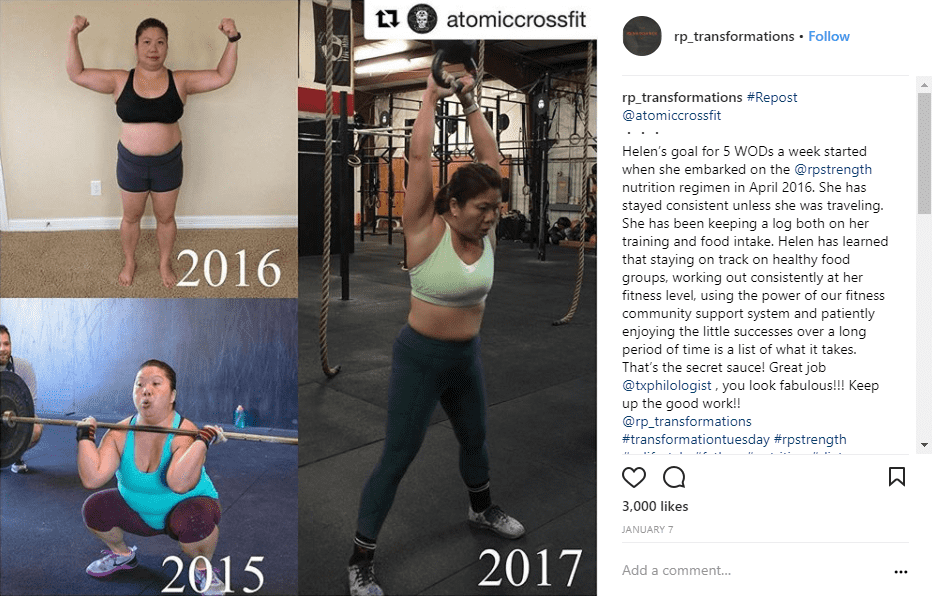 Source: Renaissance Periodization
Source: Renaissance Periodization3. Nutrient Timing
Nutrient timing means determining when during a day it is best for your body to consume the nutrients it needs (in accordance with your goals). This is best understood when it is split into meal frequency and timing in relation to activity.
This can be broken down even further into the 3 macro nutrients, and how often should they be consumed and in what portions throughout the day.
“So long as you get your calories and macros right, timing is a much smaller concern, responsible for at most about 20% and possibly as little as 10% to the total impact of a diet plan.”
Points to consider
- Fats and fibre should be largely avoided close to or during the workout
- Any number of meals works well, but best results are likely in the 4-6 meal range per day
- As long as protein is eaten in all meals, post-workout protein timing may not matter
- Eating most of your daily carbs pre, during, and post workout seems to have a small advantage
4. Food Composition
This refers to the quality of the food, and the way that you combine foods to create meals.
For proteins this relates to the bioavailability of the nutrients, for carbohydrates it refers to the fibre quality and the Glycemic Index. With fats a good rule of thumb is to try and stay away from Tran Saturated fats (fast food etc) and consume Monosaturated (Avocado, nuts and their butters, olive oil) and Healthy Saturated fats (Coconut/macadamia nut oils, grass fed animal fats) wherever possible.
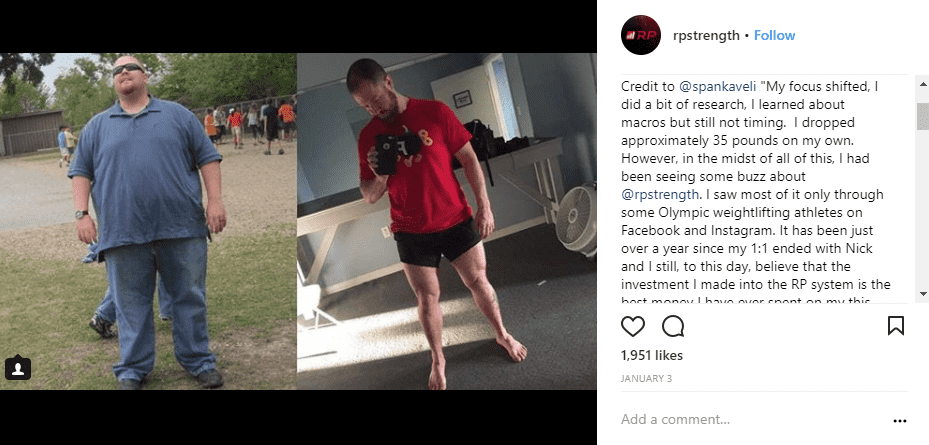 Source: Renaissance Periodization
Source: Renaissance PeriodizationEstablishing a Template Rather Than a Meal Plan
Generally, a meal plan will tell you exactly what to eat and when to eat it. However, although it works in theory, a rigid, inflexible plan usually does not often survive the demands of family life, a career, changeable training hours and the unforeseen circumstances that are part and parcel of a contemporary life. Unless you are a full time professional athlete, they can be almost impossible to fulfil, therefore, your goals will not be achieved.
A meal template is just as (if not more so) detailed, but adjusts according to your precise lifestyle and goals. All Renaissance Periodization templates can be specially tailored to suit your exact goals, from fat loss to muscle gain, but follow the same tried and tested principles. They are based on your sex, bodyweight, height and age.
Transition Periods Within The Templates
They include phases that adjust the precise amounts of macronutrients you will need, based on how your body is changing at that particular time. You will also be given a weekly rate at which you should be losing weight, and if you are within this rate then you know that you are on track.
If you are not losing enough based on the range that you have been given, then you can revert to the next phase within the template, and this will tighten up your nutrition even further, resulting in a faster rate of fat loss.
For example, my goal is to gain 5kg of muscle. I was supplied with a personalised template from Renaissance Periodization that consisted of the following 5 phases.
- Base
- Muscle gain 1
- Muscle gain 2
- Muscle gain 3
- New base
Once I have adjusted to the base template then I will progress onto muscle gain 1. At this stage the desired weekly rate of gain is between 0.25lb and 1lb (0.11kg and 0.45kg) per week. If it slows to below this range of growth then I progress onto muscle gain 2, which will provide a different calorie balance and macronutrient ratio in order to speed up the rate of muscle gain.
In the case of fat loss, the temple would have a similar structure, but you would progress through various fat loss stages (1,2 and 3) before reaching your desired goal. The new base would then be a template for your new weight. Your caloric intake will be calculated appropriately, but this may change over time, and that will be included in the template itself. This also makes the entire template easier to stick to.
How To Maintain Your Goal Weight and Avoid the Return to Bad Habits Once the Diet is Complete
One general problem with most diets is than even when any individual sticks to a program religiously, once it has been completed, then it is easy to slip back into bad habits and regain the weight that has been lost.
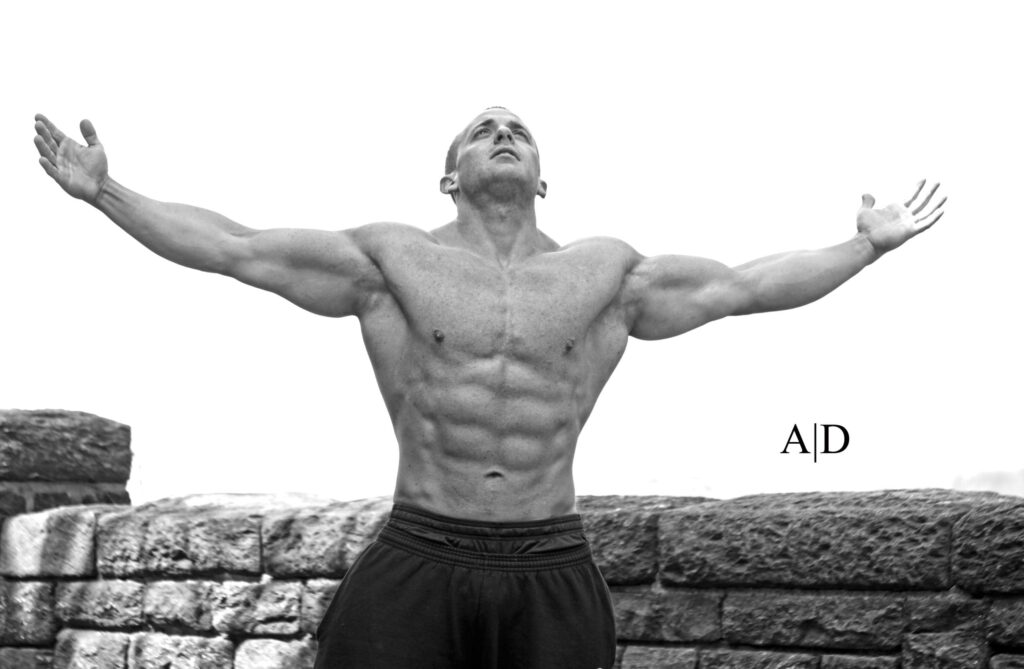 Source: Renaissance Periodization
Source: Renaissance PeriodizationThe in-built transition periods of the Renaissance Periodization Templates that I described above are designed to help combat and overcome this problem.
Once you have achieved your desired results, you then adapt to the new base template that will help you to maintain your newly achieved weight.
The templates allow you to:
- Establish and maintain consistency and healthy, long-term habits
- Pick the foods you like from a pre-approved list of options
- Change your nutrition at a rate that suits you
- Achieve your exact goal whether you are a total beginner or an experienced athlete
For example, if you are a CrossFit athlete looking to build muscle because you are not as strong as you would like to be, but you also need to maintain consistently high-performance levels, then the calorie balance and macronutrient ratio will be carefully calculated to ensure that your body is fed with enough protein, whilst also maintaining a high enough level of fats and carbohydrates to fuel performance.
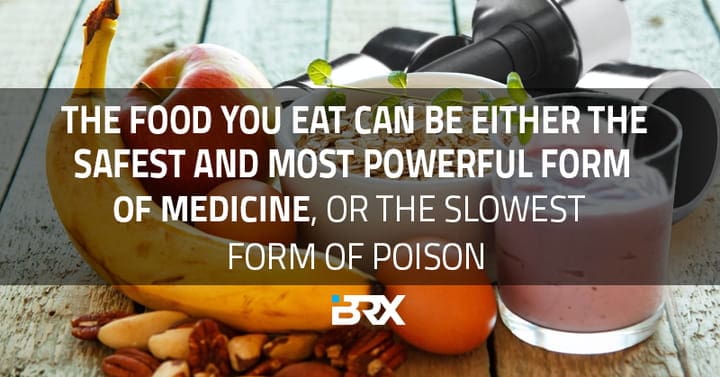 Source: BOXROX
Source: BOXROXIf you want to lose fat, making gigantic changes all in one go is the best way to make this process harder than it needs to be.
The formation of positive eating habits, of building an understanding of the right food choices, of establishing the 80% combination of the correct caloric intake and macro nutrient ratio are all programmed into the template itself in order to ensure a positive routine and the achievement of your respective goal.
Renaissance Periodization work with athletes and individuals of all ability levels, backgrounds and sports and help them achieve their own personal goals.
They offer introductory level ebooks, nutrition templates and a premium one to one coaching service, depending on your exact requirements.
The latter is the service that athletes such as Sara Sigmundsdottir and BK Gudmundsson have utilised to great effect. So, if you are serious about losing fat, building muscle, improving performance and transforming your body, then now is the time to act and take a step on the journey towards becoming the best version of yourself!
Image Sources
- Original Priorities Chart: Renaissance Periodization
- Crossfitter: Renaissance Periodization
- Chris Harris: Renaissance Periodization
- nutrition: Squats & Pixels
- Crossfitter transformation: Renaissance Periodization
- Body Transformation: Renaissance Periodization
- Athlete: Renaissance Periodization
- quote card nutrition: BOXROX
- Capture: Renaissance Periodization
